Interview 089 • Apr 7th 2024
- Interview by Asa Featherstone IV, Self-portraits by Heather Evans Smith
About Heather Evans Smith
Heather Evans Smith is a photo-based artist whose work reflects her southern roots, motherhood, womanhood and a whimsical imagination she relied on as an only child in a rural town. Her photographic imagery explores the ideas of memory, loss and family in conceptual settings.
Smith’s work has been exhibited in both solo and group exhibitions at venues including the Fox Talbot Museum in Lacock, England, the Nasher Museum of Art at Duke University, NC and Leica Galerie Milano in Milan, Italy. She is a Critical Mass 2014, 2018 and 2021 Top 50 recipient, 2022 Silver List artist and the CENTER 2022 Me&Eve grant recipient. Her first monograph, Seen Not Heard, was published by Flash Powder Projects in 2016 followed by two self-published monographs, Alterations and Blue. She resides with her family in Chapel Hill, North Carolina.
Links
Foreword
Heather’s work is guided by memory: people, places, and moments.
Although our lived experiences are far from the same, I still felt connected to her work because of her willingness to be emotionally vulnerable. Through her layered images, Heather challenges herself and the viewer to reassess the value we place on the time spent with ourselves and the ones we care about.
We touch on her creative evolution, discussing the importance of recording memories, preserving familial bonds, and the influence of her Southern roots on her daily practice. We focus on three pivotal projects—"Seen Not Heard," "Alterations," and "Blue"—tracing the threads of her artistic journey and ending with a brief discussion about her upcoming project “Skipping Sundays.”
----
This interview has been edited for clarity and content.
Interview
What’s your first memory of getting into photography?
Well, my path was kind of interesting. I got my degree in visual communications. I did a little photography, but I also did drawing, painting, and graphic design. I went into graphic design for 14 years, and I loved the first 6 months of that 14 years. Haha.
Why only that first 6 months?
You know, in college, you do all these funky, cool designs, and then in the real world you have to have clients where you can pay your bills. So, I ended up doing a bunch of John Deere catalogs and that kind of thing. But I had always loved photography, and digital photography started coming into fashion. I bought a camera and honestly thought I was just going to take pictures with friends just for fun.
I started putting stuff on Flickr, got a little bit of a following, and just played with all different genres. Conceptual photography was what drew me in. I also tried weddings, and families, but dropped those out really quickly. That wasn’t for me.
Haha, right. So ultimately you chose photography over design because…
Because the lighting and composition of a photograph had a certain allure to me, which was missing in my design career. Additionally, I felt that there is this soul that exists in photographic artwork, a quality that is often hard to come by in design.
That said, I feel like my background in design has helped with my photographs, especially when it comes to color, composition, layout, and presenting and organizing my client work. It’s a great skill to have because I don’t have to pay anyone to design any of my materials.
I can see that. What kind of design did you originally want to do?
Well, honestly, in school we designed CD covers, postage stamps, and all this cool stuff. And then I got out in the real world, and sometimes I did cool projects, but most of the brochures and pamphlets I was designing weren’t very exciting.
I knew it was a good way for me to make a living. I needed to do that. However, I think out of all my classes, darkroom photography was my favorite. I just didn’t know what to do with it going out of school. So, I started working at an advertising agency. I worked at several of those for a long time.
It wasn’t creative enough for me, so when I got back into photography, I started with self-portraits, mainly because I was always available. And I named them “lunchtime self-portraits” because I lived like five minutes from work and made them during my breaks.
I’d run home, think of a concept, take the picture, and then come back to work. And if I was like five minutes late coming back, a friend of mine I worked with would call me out for taking pictures again. Haha. At the time, it made me feel better about working the agency job because I knew I had this creative outlet on the side. But then after a while, I realized that I’d much rather be spending all of my time doing that.
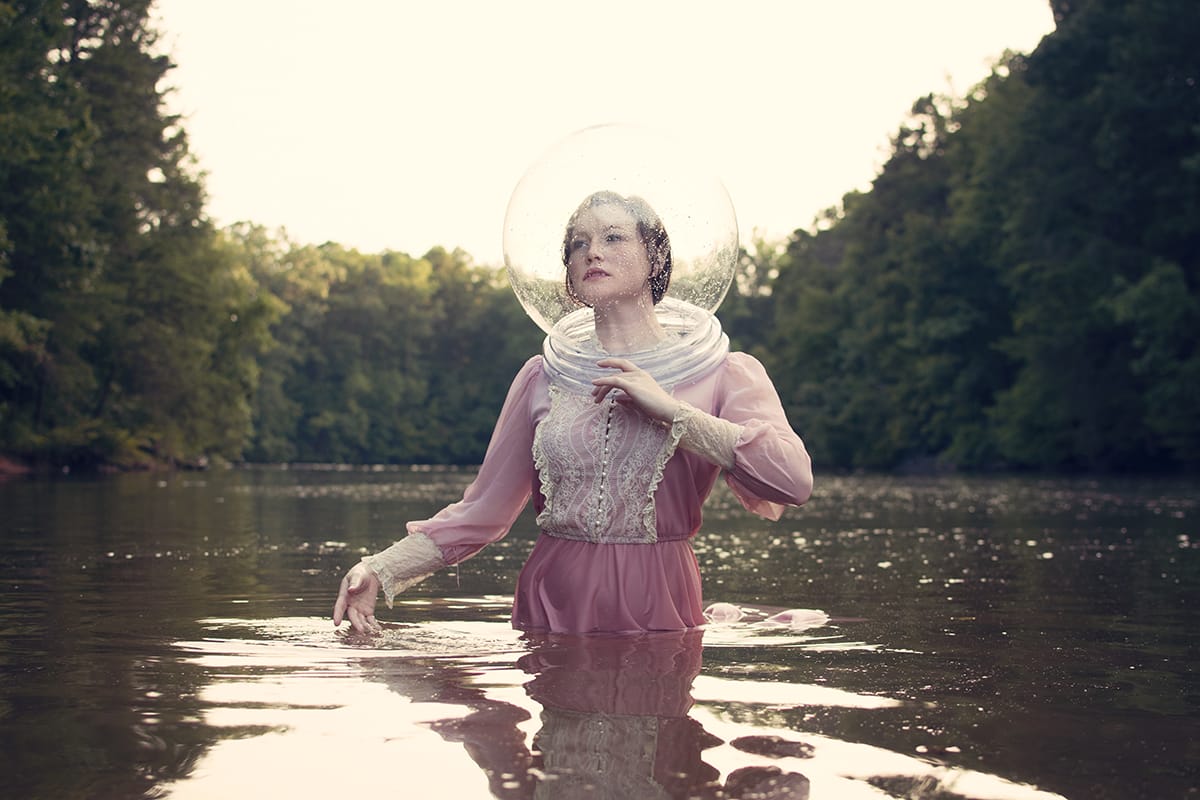
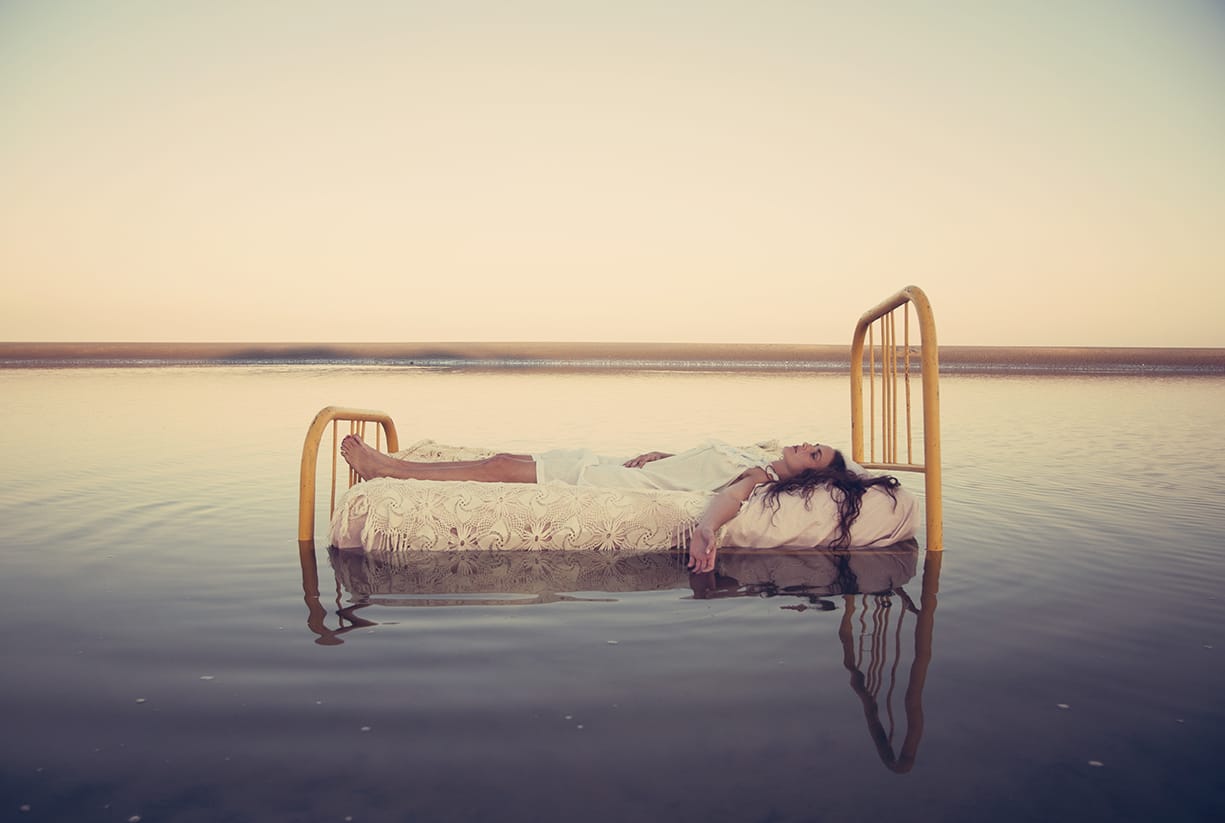
left, Stranger on this Earth; right, Wade
Mm-hmm. What was it like taking those self-portraits? Aside from the fact that you were always available, why did you keep taking them?
I guess when I was initially taking photos, it was just something that felt free and fun. Back in those early days, if I found a vintage item or prop, or thought a random idea was cool, I would take a picture and that’d be the end of it. And, I kind of miss those days when you’re not concerned about a body of work and everything having meaning.
It wasn’t all self-portraits, though. I used my friends sometimes, but as my work started to change and become more personal, I felt like it made sense for me to be in it, because I was covering stuff that I was going through. And then I started shifting a little bit onto my daughter because she could represent me in the past.
Oh, yeah! That makes sense with so much of your work being centered around family and memory. What led you down that path?
I guess the first series that I feel like I did that with was “Seen Not Heard”, which was about a mother-daughter relationship. And that project was a complete accident because I was exhibiting another body of work when a woman came up to me and asked, “What are you doing next?”
By the way, I hate it when people ask that because I’m just like, “Is the work I’m showing now not enough for you?” Haha. Anyway, I panicked and told her that I was going to make the same type of images but use young girls to see how it changed the narrative.
After that night, I realized that it was actually a great idea. So, the first photograph I did was with my daughter, and I couldn’t believe she let me do it because she was only four at the time. After that, I decided that I wasn’t going to be using any other kids because the project was going to be about us, and memories of me growing up with my mom. My work started to shift into something more personal at that moment.
What was it like working with your daughter at such a young age?
Um, it was all over the place! I just knew that I had to be patient throughout the process and remind myself that this was not a requirement of her.
I had to separate myself from thinking that she was my daughter and treat her like someone else’s kid. Like, if she didn’t feel like doing it, I wasn’t going to make her do it. I didn’t want her to end up in therapy later about having to be in my photos. And we always had to shoot her idea first. So, I have a version of one image, where there’s a big Power Ranger in the photo first. There were a ton of different things she wanted to do, and I just let her get that all out of her system. And then afterward she would understand that it was my turn. I also had to bribe her a bit. Haha. I’d give her little toys, and now she gets cash.
Haha. Right, because now it’s like a real job.
Yeah, she’s 14 now, I gotta pay up.
So you’re still working together?
Yeah. Not as much now, but in a few projects.
Now I’m wondering, did any of the photographs she wanted to take during her turns make the final cut for that project?
Actually, one did. It wasn’t fully her idea, but she just wasn’t into the shoot that particular day and she said, “Hand me my sippy cup,” and as she took it, she gave me the side eye and that’s the one that I ended up using. It turned out to be a happy accident.
Haha! No way. Such a collaborative process, which can sometimes be challenging when it comes to fine art photography.
It has to be. I found when she was really little, that you cannot control a child. I can’t direct every movement – I just have to let them be. There’s one image of our legs, and her foot is hooked in such a way that only a kid can do.
Her position was way more natural than I could’ve directed anyway. It worked out because she couldn’t really hold a pose, she always wanted to wiggle around.
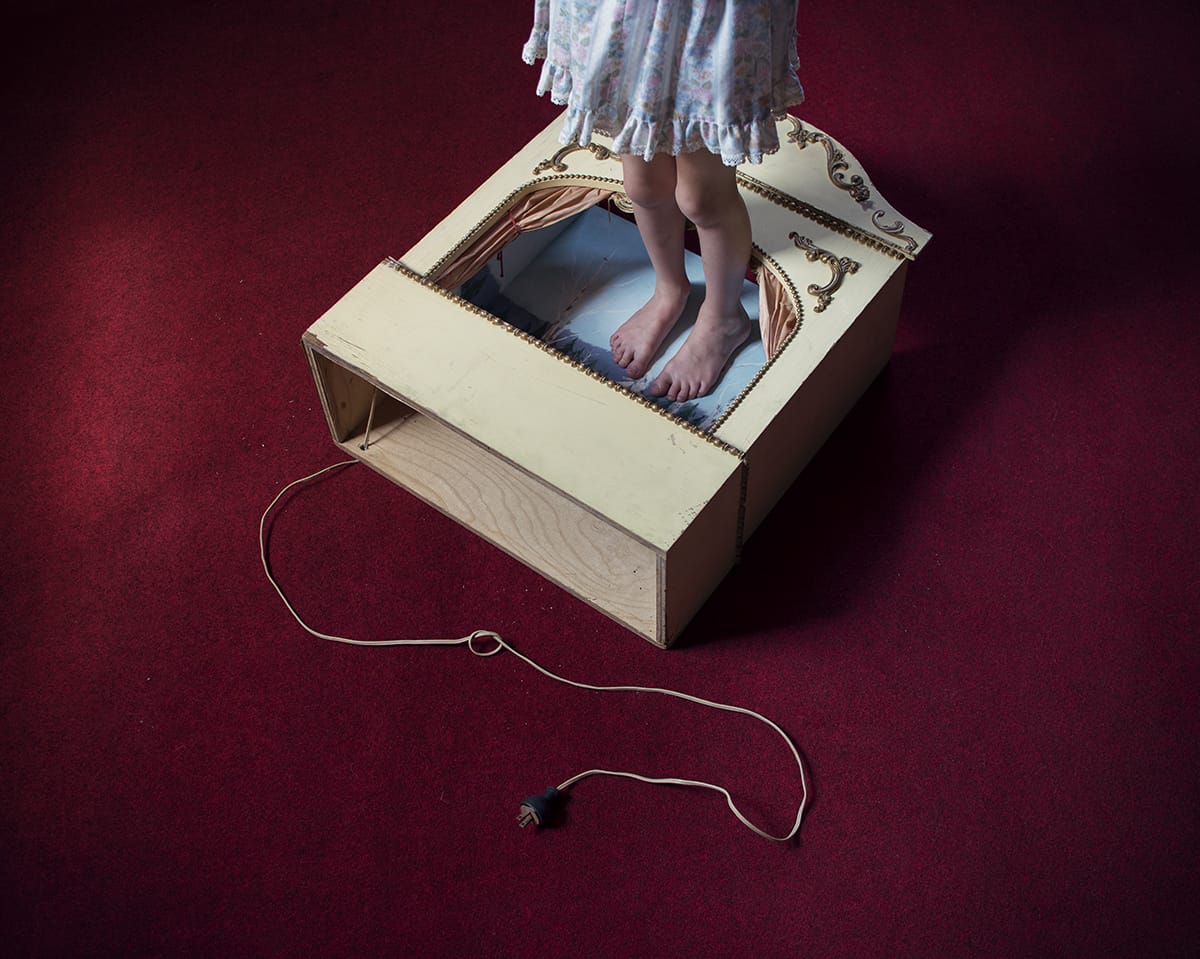
The Roles We Play
Right. I imagine shooting that series required a lot of patience, just watching her to see what happened and waiting for the right moment.
Yeah.
At four years old, did she understand what you were making together?
No. We shot for a few years, and I think toward the end, I remember having prints on the table when she stopped to look at them and pointed out some images she liked. Before, she would help me and immediately after would be off doing the next thing. Now, she’ll ask me about the meaning, go to artist talks, and have conversations about the work. When she was younger, I didn’t bring her to any of the openings for the “Seen Not Heard” show because it felt like there would be too much attention on her.
People sometimes forget how to talk to a child, and they would all come up to her asking her questions about the work. And she just looked like she wanted to fall through the floor. Now the series’ aren’t directly about her, so I feel comfortable with her coming and she listens.
Has she shown an interest in making her own work?
Not really. She was talking about being a doctor this week. She’s like, “I want to make money. I don’t think I’m going to be an artist.” I can’t blame her.
Haha. She’s real for that. Is the title for “Seen Not Heard” a nod to being seen, not heard in terms of how we teach kids to be quiet and out of the way as a form of “respect”? It looks like you composed your photographs with that in mind, with your daughter being tucked away or seated quietly near the mother figure in the photograph. The daughter was the focus but treated like a background character in a way.
Exactly. I mean, I heard that saying for years growing up in the ’80s. Especially kids that grew up in the ’50s were not supposed to be heard. I liked using that title and flipping the concept, wondering what it’d be like if we did hear these stories, these little things that are happening in this mother-daughter relationship, which is like a marriage in a way. You’ve got these ups and downs, but you’re stuck together. You have this bond, but then there’s also a natural tendency to revolt, particularly from the child-mom dynamic.
Yeah. It’s fascinating as an observer. There’s an understated tension where mothers are often protective of their daughters pushing them to be buttoned up and the daughters feel the pressure from that. That sometimes builds animosity towards each other. At the same time, so much love and care is rooted in those actions. I think that you captured the early stages of that relationship well.
Yeah. Well, that’s it right there. There are so many emotions involved and I get it all: all the pushback and all the anger about what’s going on in middle school life, but then I get all the good stuff too. Sometimes I think it’s better to create a space where your kid is comfortable enough to spill it all out on you than feeling like they can’t.
It’s hard being a kid and I think like all day long you’re having issues with friends, and you have to keep that inside, but then you come home to the people that you know so well, and that’s when everything comes out.
Yeah, well, you want to have a soft place to land at home where you can just kind of release and relax.
Yes.
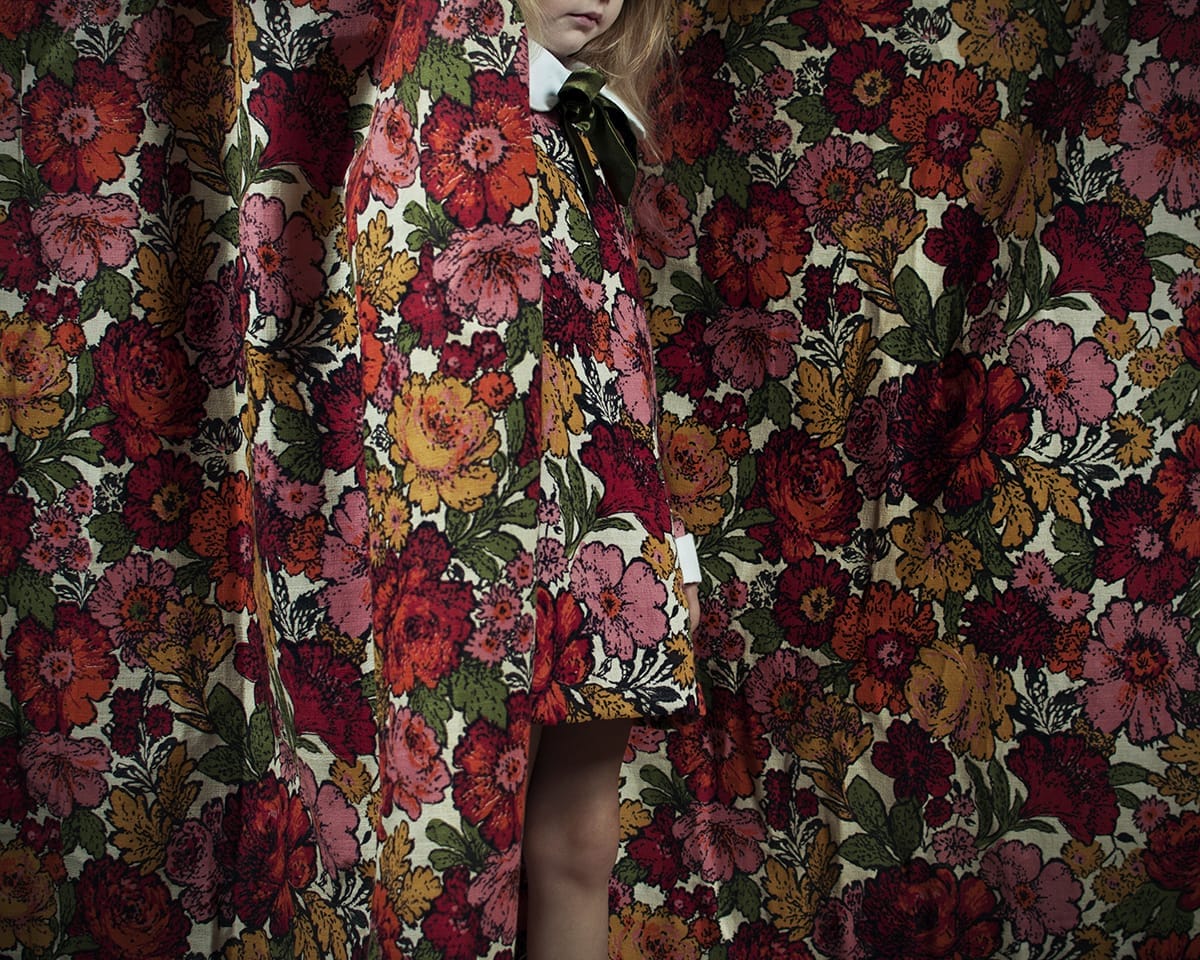
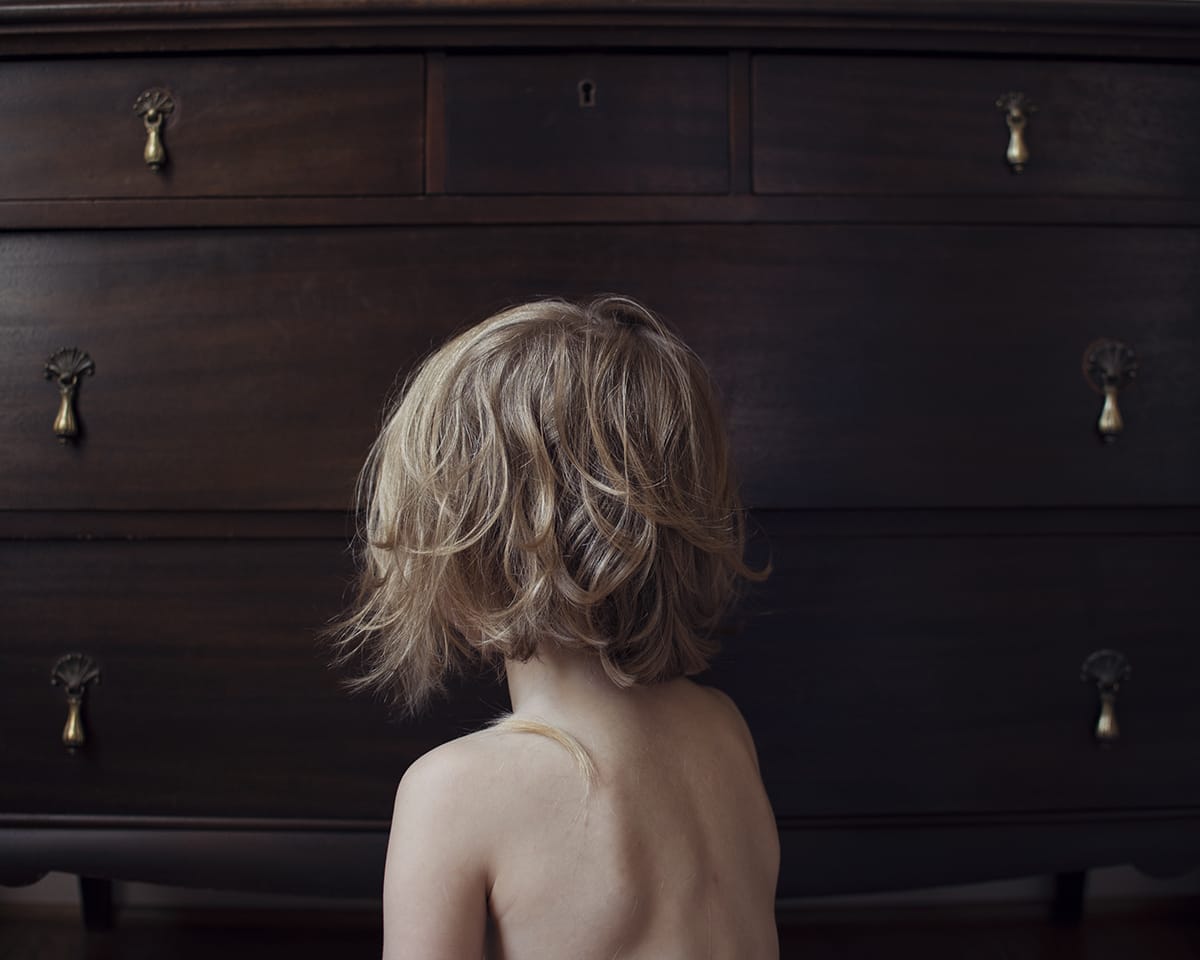
left, Wall Flower; right, Shear
Why was memory something that you wanted to investigate in the first place?
I think just getting older and as I’m experiencing people around me passing away and realizing that all you have left are these memories. And sometimes I wonder if I’m even remembering things correctly. So, some of the images may not even be right, but it’s just how I remember those moments. For instance, my series, “Alterations” was about my grandmother, who was a seamstress.
That’s one of my biggest childhood memories: going into that department, hiding in the dressing rooms, and sticking my hands in this big bin of old buttons. In my mind, I had this idea of what it looked and felt like, so I tried to get the colors and the props and all that to match. But I wonder if I was transported back there, would it even look the way that I remembered it? I’m drawn to, not only memories but thinking about the self, moving through life, and the changes that happen across different stages.
Yeah. And a lot of the memories you explore seem centered around family. I noticed that with your “Once Removed” project, where it looks like you were revisiting archives of family photographs and making some alterations.
Yeah. That was a kind of a pandemic project. I had started working on another series centered around depression, called “Blue,” at the beginning of 2020, but then COVID hit. I was trying to figure out how to homeschool my daughter, where to get toilet paper, and had no desire to work on a depression series at the same time. I started doing other things to keep my brain and hands busy.
So, I printed out these family photos on canvas and learned how to embroider over them. And then I would reframe them in frames that look like how I imagined they would’ve been. They looked normal at first glance, but after looking closer you could tell something was off.
I used photos of my grandparents, and my school pictures and made the project to ask whether we truly remember things as they were, and if we would make different choices if we were given the chance.
So, those weren’t original family photographs?
No, no. I printed them on a fabric.
Oh, okay. I figured your family would have a thing or two to say about that if they were. Haha!
Yeah, and in the exhibition I had for the “Alterations” series, I took every picture that I could find of my grandmother, printed them to look as close to how they looked in real life, and then sewed them all together in chronological order.
My mom looked at the work and was so shocked, but I told her they were copies. There’s no way I would sew the originals together. Haha!
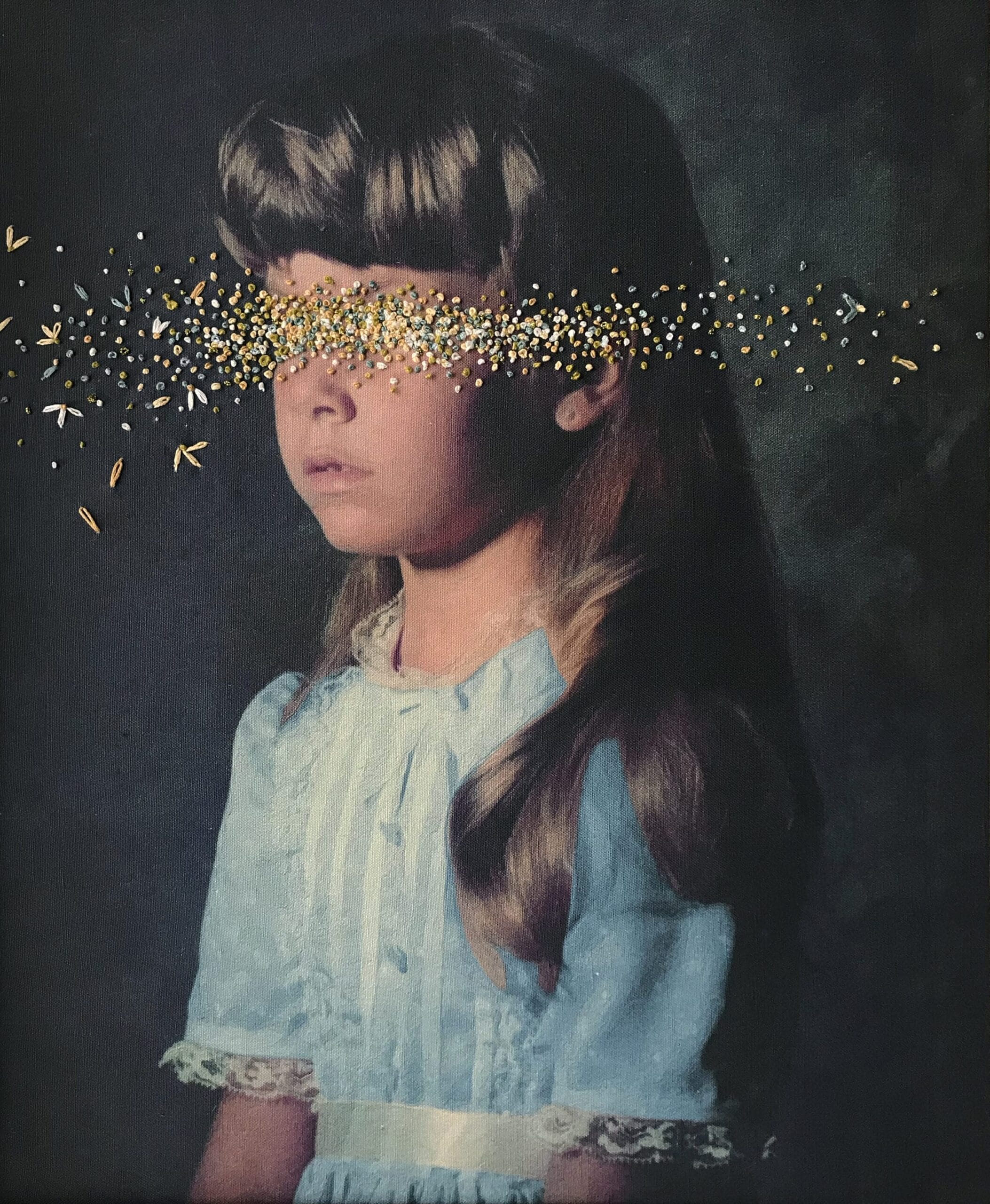
Me at 6
In general, what does your family think about your work? Especially with you sharing such personal moments.
For the most part, everyone is understanding. Well, my dad has passed now, but he was interesting because I think he thought a lot of it was a little weird. But if I ever needed him to help me with any part of my work, he was there. He was there if I needed him to make a box or build part of a set. I have this outtake of a self-portrait of me in the ocean, with this black fabric. And there’s a picture of him holding it because I needed someone to throw it up, and he’s giving me this look like “I don’t know what she’s doing, but I’m helping her anyway.” It’s so funny to me. And my mom is proud of me.
I’m working on a new series about the complexities of faith and I’m honestly not sure how that’s going to go over with the family, but you can’t argue with the way someone feels about their experience.
I agree. What are some of your favorite memories?
You know, let me think about that. There are so many things that you just don’t think about as being a favorite memory until you get older and it’s over. When I was driving for a couple of hours this weekend, I put on these songs. And they were the songs I remember being on the radio when I was a kid on a long drive in the back seat, just trying to go to sleep.
And now, I want to listen to those songs because they put me in that time when I didn’t have any worries. You had people taking care of you. I just remember summers; we lived out in the country and had a small pool in the backyard with the radio going and…it just felt nice.
Mm-hmm. Things were simpler. I’m stuck on the comment you made about the paradox of enjoying the memory of the moment rather than the moment itself. Is that something you think is natural to the human experience?
I don’t know. I feel like it’s so hard when you’re a kid, that’s what they say youth is wasted on the young. You don’t fully appreciate life. I remember always being stressed out, even in my twenties, about who-knows-what. If I could go back with the brain I have now, I’d hardly have anything to worry about. Even ten years ago, I look back at things like, “Wow, that part of my life was nice.” When I’m in that time, I never think that it’s a great moment. I just live through it and reflect on it later.
Knowing that, have you actively sought ways to enjoy every day?
You know, I need to be better about that. I was listening to a podcast yesterday talking about recognizing things that you need to be grateful for. And I was thinking, that’s something I need to do more. I also live with a middle schooler, so there’s only so much I can do. Haha.
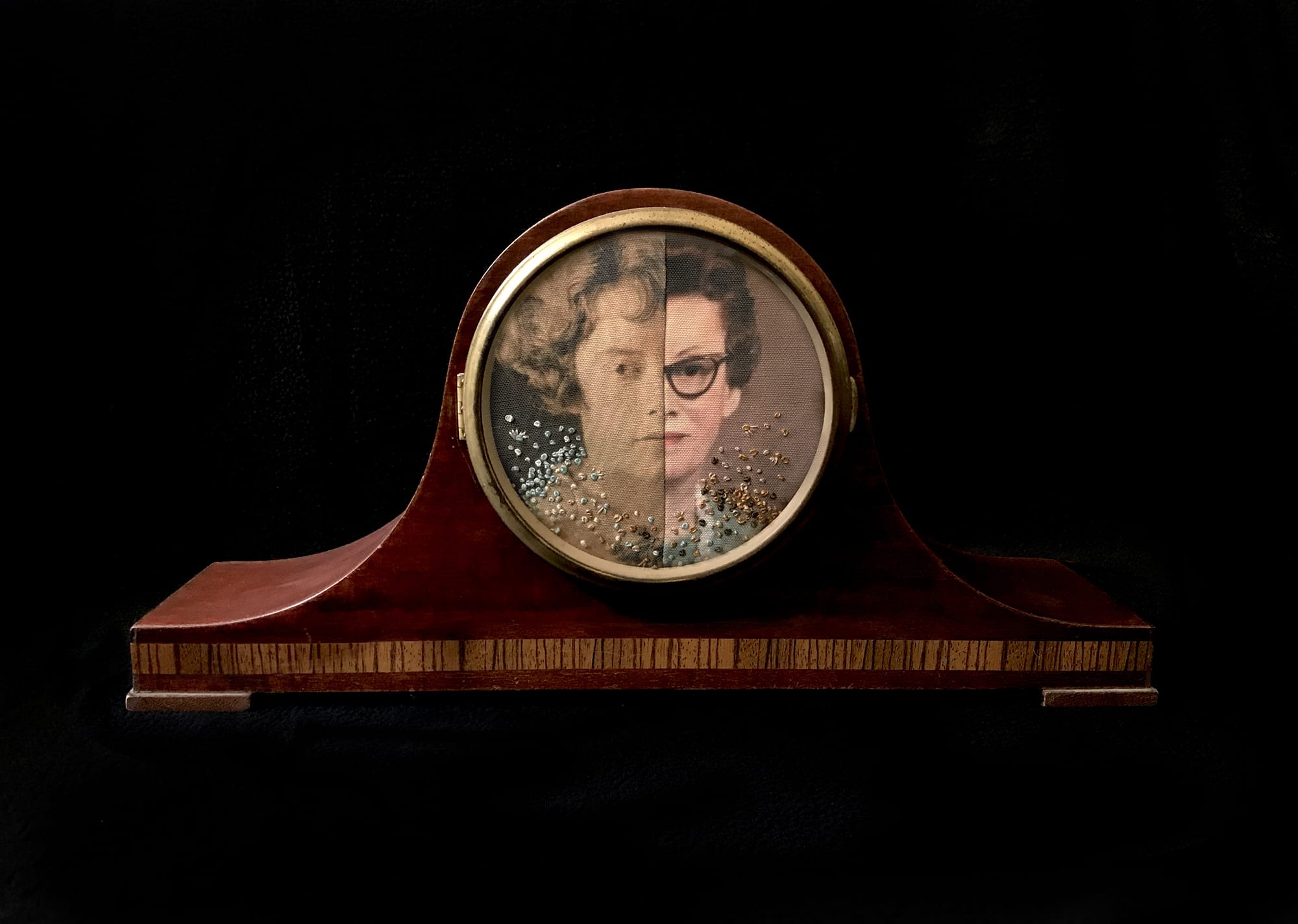
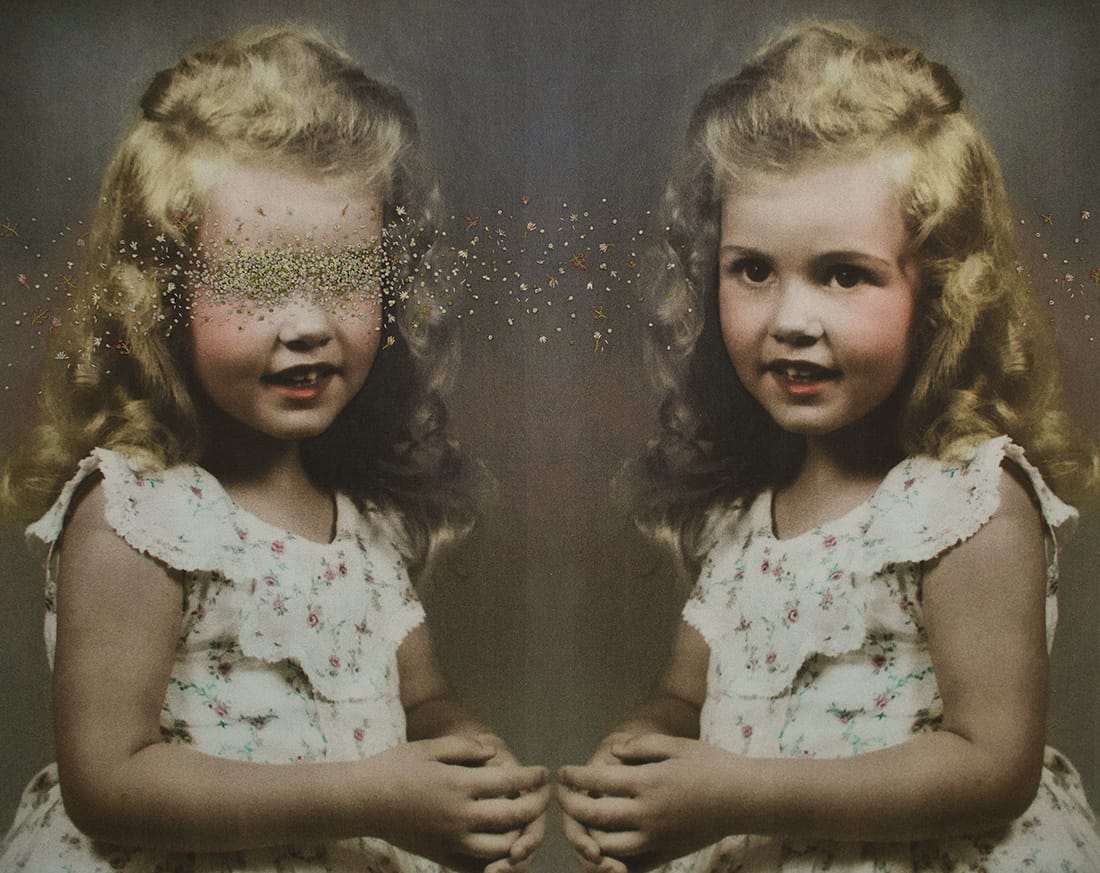
left, If You Could Turn Back the Clock; right, Dust
Enough said!
At the same time, our weekends are pretty quiet and we just like hanging out on the couch and watching movies. I remember that growing up: my parents picking out a movie and just watching a lot of movies together doesn’t seem like a big thing, but you do miss that later.
Those moments are so valuable, especially with family members if you have that access.
But I think it’s the everyday memories you make that hold more weight than one specific moment, you know? Like, going to my granny’s house every Sunday for lunch. I think it’s the routines that you’ve had for so long that build great memories, and make you miss them when you don’t have them anymore.
Like rituals. And you never know when the last time you’re going to do that thing is until it’s long past. I remember growing up, almost every day riding bikes with the neighborhood kids and hanging outside until late at night in the summer. Eventually, it just stopped, but I can’t remember when.
Exactly that.
Can you tell me about your project, “Blue”? It was a way for you to work through the loss of your father, right? How soon after that loss did you know you wanted to make work about it?
So, he died in November of 2019, but even before that, I was starting to feel a sadness creeping in. I couldn’t pinpoint what it was, and then when he died, it just blew everything open. Nobody told me exactly what it would be like to deal with that. I just thought I’d be really sad. I didn’t know I’d have physical ailments. And then when I started talking to people, they were like, “oh yeah, this happened to me” or “I had chest pains too.” Your body just goes haywire when you’re dealing with a big loss like that.
I was trying to move through it for months, and I knew I wanted to make work about it. So, I started it in the beginning of 2020. I think I shot two photos before COVID, but stopped because it was just too much. I just didn’t feel good, but it worked out for me because it gave me the space to find a therapist and get a low-dose medication to alleviate the physical symptoms that were happening at the same time.
Around January of 2021, I felt ready to make work again. And I’m never the kind that just consistently shoots over and over, but that whole year I was coming up with ideas, and shooting them made me feel good. It’s funny because I would post the photos on Instagram as I was shooting them, and I think people thought I was in a bad spot when actually I was happy getting these out in the world. It was a release for me.
I didn’t realize how much it resonated with other women until they started reaching out. So, I decided to make a book about this work to share. And when I put the book together, I asked people to send me their stories and quotes from their experience and I would weave those in with the photographs. The project grew and turned out to be not only my story but a lot of people’s stories.
Wow. What made you decide to post the photos as you were making them rather than wait until the project was finished?
I tend to do that. I hardly ever save everything up until the end. I just like to hear what people have to say about it as I’m creating. Not for the engagement numbers, but for seeing if the work moves people.
Did the response you were getting impact the direction you took the series?
Well, I think it just made me realize what I was doing was important. Ultimately, I’m going to select what I like for the final edit, but it’s nice to see how people respond, you know?
This was particularly interesting because—even though I talk about relationships and memory—this was the first time I had to stand in front of people and let them know that I was depressed. It was more personal than what I’d done in the past and putting that out on the internet and an artist statement was tough. But I knew it was important to do. And in the end, so many people thanked me for making it.
I can imagine. It’s like you were giving voice to things that people have been feeling but didn’t know how to communicate.
Exactly.
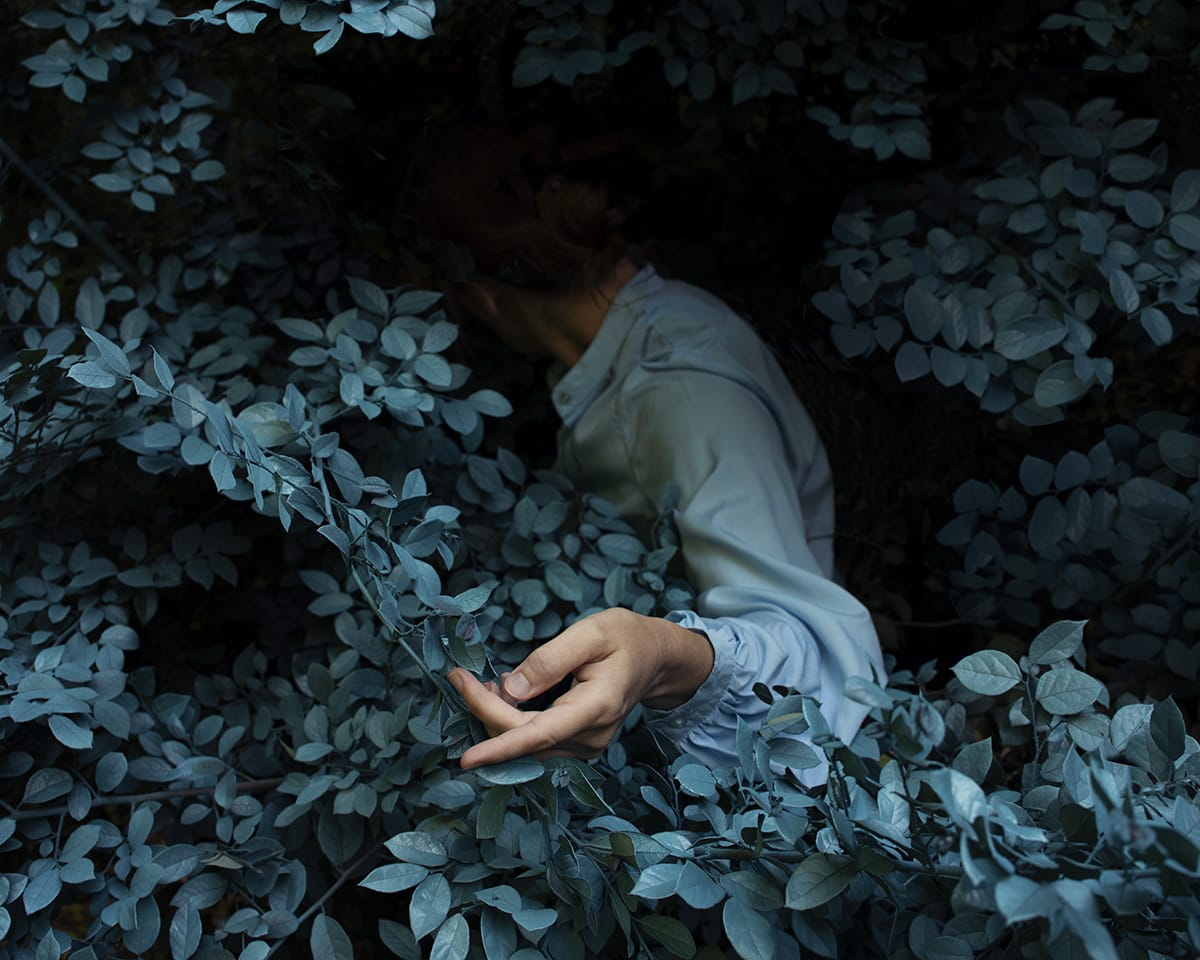
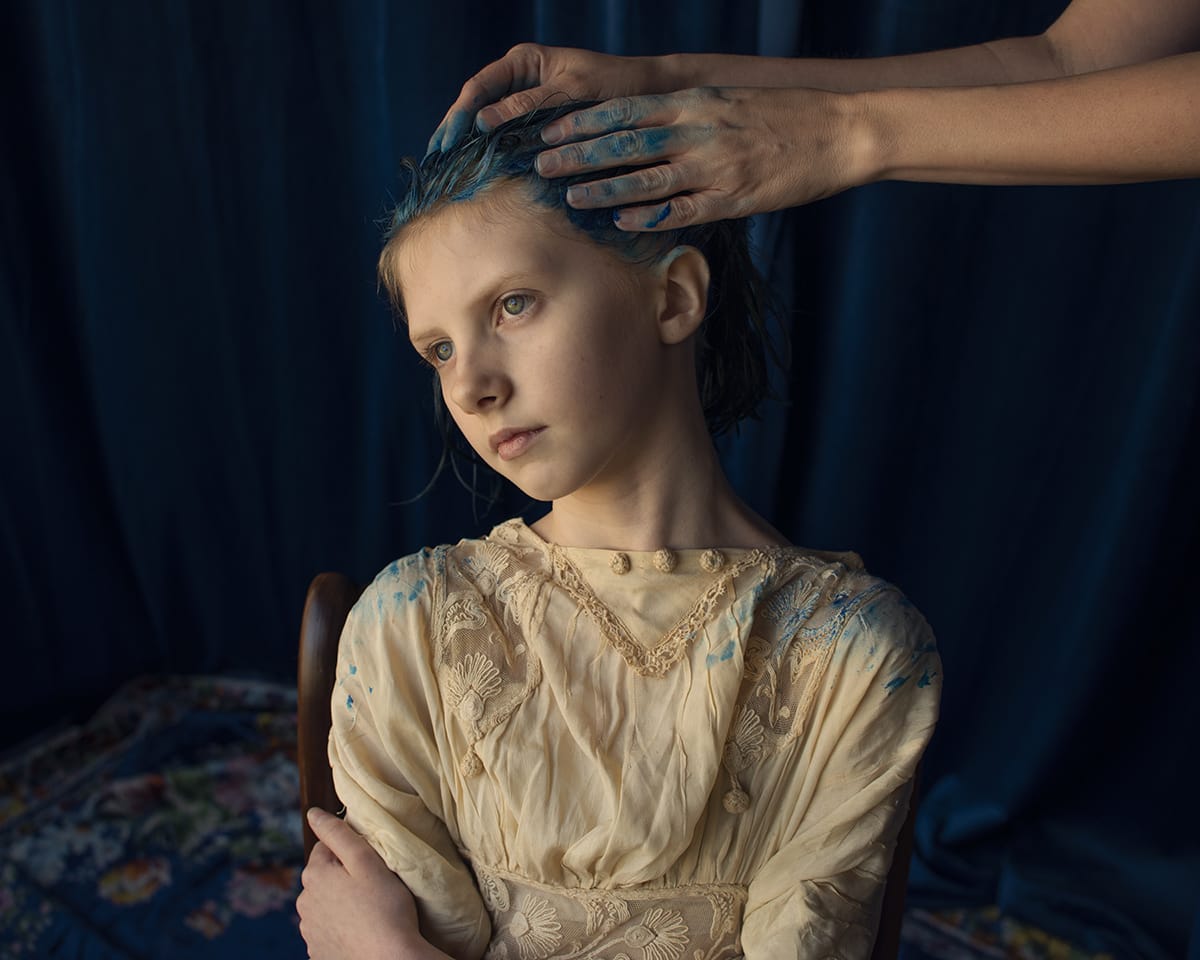
left, Paint It Blue; right, Stain
This project resonated with so many folks and, specifically, other women as you mentioned, but how was the process impactful to you?
It felt cathartic. With a lot of those images being about my dad, it felt like something I needed to go through. It was a way for me to work through everything I was feeling. I was trying to do that when I initially started the project, but I think it was too close to the time of his passing to continue. I remember I was told when you’re feeling the anxiety to write, and so I would just write really fast, but making this series is what helped most. I got to just sit there and think.
It was also a distraction in a weird way. I mean, even though you’re focused on the message, you’re also distracted by the other parts of creating it: getting the framing right, focusing on lighting, that kind of thing. Which helped in its own way.
Right. And the title, “Blue”, is a clear nod to grief and sadness. Are there any other layers to the name that maybe we didn’t pick up on?
I think it’s this whole mesh of things that I notice as a Gen Xer. We were the first generation to collectively start having children later in life. That means that we have young children at the same time as aging parents, which now doesn’t seem like a great combo. Haha. And then, you move into your 40s and start to have this hormone fluctuation.
You have this perfect storm of things happening and life itself feels impossible sometimes. And I wanted to touch on all those different things in the series. You know, parents aging, raising children, and hormones changing all at the same time.
I’ve never thought about it from the generational perspective. A lot of things you’re speaking about are things that people typically keep close and private. Do you feel any discomfort bringing these topics to a public space?
I think there’s always going to be a little bit of discomfort there. Just because you can look me up and see all my business. Hopefully, it won’t bite me later on, but I feel like all the different series I’ve created have slowly started to reveal more about myself.
I’ve just gotten used to it at this point. I’ve also gotten older where I care less about what people think of me. As a result, good things have happened. I think there will always be a little bit of discomfort in doing that because it’s not natural for us to show our weaknesses, particularly online.
You’ve been pretty transparent online about your shortcomings, like when you’re applying for grants and things don’t work out. What made you want to start doing that?
Well, it was like a year ago when I saw an author make a post saying that nobody showed up to her book signing. And then all these famous authors tweeted back saying that similar things had happened to them.
It felt so nice to see people being honest with each other. So, I made a post listing the number of things I applied for against the number of things I was actually awarded. So many people commented with similar stories. It was nice to create this little collective. Hardly any of us know what we’re doing or have it all figured out. Life isn’t full of roses and wins.
I decided to post that at the end of last year, and now I’m thinking about doing it again to make it a tradition.
Something like, “Here are all the things that I got rejected for this year…”
Yeah. Like I applied to 30 grants and got 2. I’ve had lunch with photographers that I thought had it all together, but it’s the same story. They tell me all the struggles that they’re having and it’s nice to know that I’m not alone, everybody’s just kind of trying to get through the muck out here.
Yeah, it’s tough. Living online makes it impossible to truly know. All you’re shown is an award at the end, not the years of work leading up to that moment. I think a lot of folks are tired of the facade.
True. I applied for the same grant three years in a row and got it on the third try. There are different jurors every time, and you don’t know who will respond to what. I’ve gotten to the point where I look at the jurors now, research to see what they typically like, and can sometimes assess whether they’ll like my work or not. It helps me be a little more specific about what I apply to. Even still, it’s mostly rejections.
Still, that’s a nice pro tip! How did you structure your ideas for “Blue”? Every shot feels specific and meticulous.
I sketched most of them out, but then some ideas would just come to me, and I worked on those while they were top of mind. Some of them only took me a few days to get from idea to finished photo, but others took maybe months. It just depended on if I had all the materials and props I wanted.
Once I started noticing the ideas repeating themselves, I knew I was probably done shooting the project. Like, the last few shoots just didn’t work, and the curator of the exhibition I was working with told me it was a sign that it was completed.
How’d you decide what elements you wanted to include? For example, using the butterfly in one image, a model horse, and pills in another.
Well, I always like to use flowers, insects, and butterfly wings because they symbolize something beautiful, but fleeting. Kind of like life. My medicine just happened to be blue and that got me thinking about using pills. But, a lot of the time my biggest prop was spray paint. There were so many things I just had to make blue: part of a bush, the horse, the ground.
And I spent a lot of time on Etsy and eBay looking for stuff. Usually, I was looking for something specific, but there was one image that had a fuzzy, blue scale, and that popped up randomly. I was originally looking for a blue shag carpet but thought the scale was strange, and immediately gave me an idea.
My dad had a heart condition where he would gain fluid and needed to weigh himself daily, and if he weighed over 200 lbs., he had to go to the hospital to have that taken off. So, seeing that scale gave me the idea. I’m always open to those little accidents.
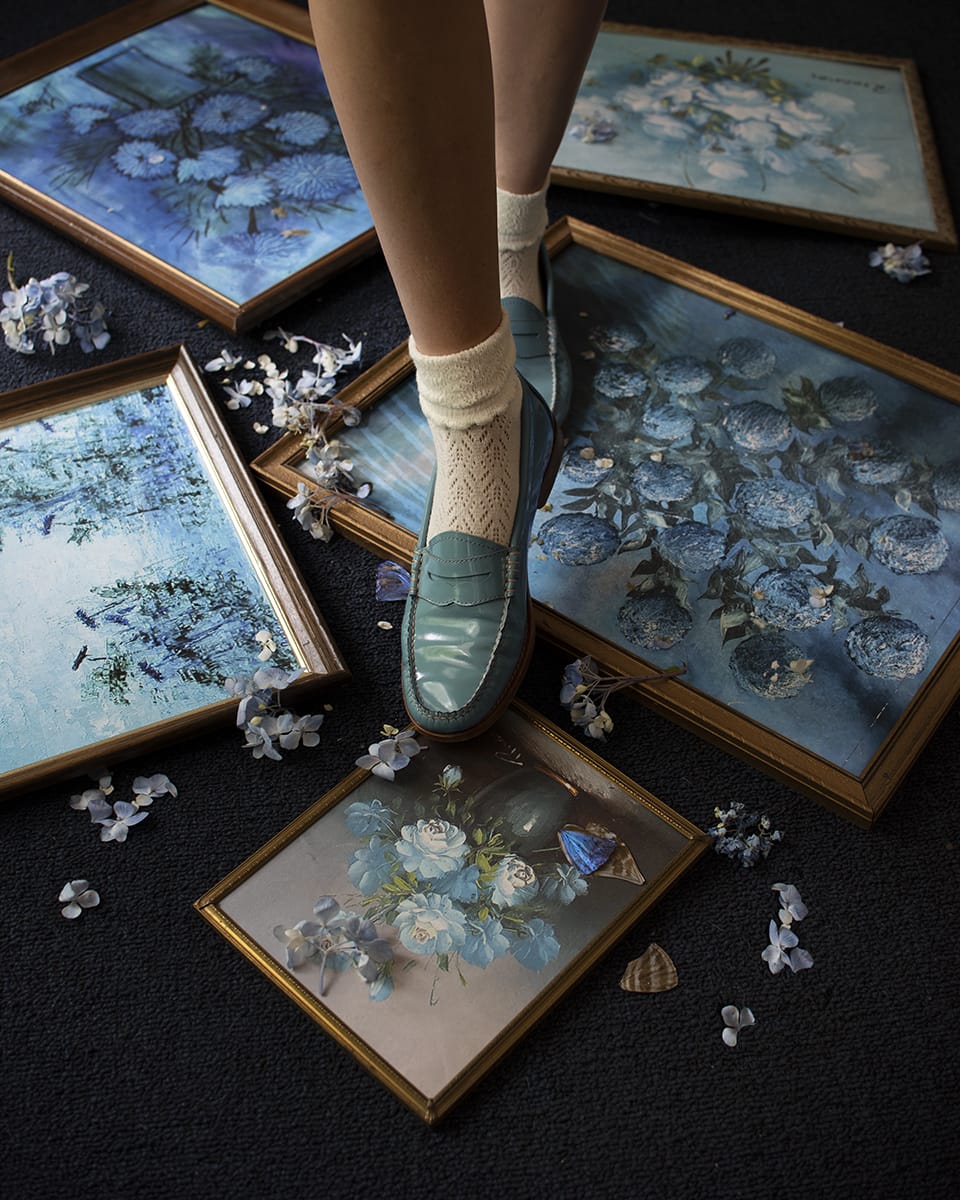
Navigator
Understanding that your work relates to a lot of people, do you feel any responsibility to continue to make a particular type of work?
I don’t really feel that. I mean, someone asked me if I would continue making work about depression, and I just don’t feel like I want to be that person, you know? Of course, I still want to show this work, but in terms of making new work, I feel confident to move on to different subject matter. Maybe people will move on with me, or maybe they won’t.
I respect it. So, looking at your earlier work with what you’re making now, you transitioned from exterior open shots to more interior, smaller sets. Was that intentional?
Sort of. I think I knew when doing the mother-daughter shoots, it just made sense for it to be inside working with a child, rather than finding different locations for every image. And then I really got into using the natural interior light and making things have this painterly quality to them. I’ve just been rolling with that ever since.
Now that you mention it, I’m seeing the painter vibes. I’m also seeing faces being covered or obscure in a lot of your images. Is that for privacy reasons, or more of an artistic choice?
I think it is a combination of both factors. I obscure faces to add an element of mystery to the image and privacy for the people in the photograph. Additionally, I feel that viewers can connect with the photograph on a deeper level when faces are not clearly visible, allowing them to project themselves into the scene. This can create a stronger connection compared to when the image is a straightforward portrait.
How’d you decide which colors to use in each series? There’s a uniformity in the way you present your projects, but each one still has its own personality. Even down to the way the books were designed.
Color for me symbolizes different eras and different feelings I’ve experienced in life. For example, in the “Alterations” series, I wanted colors that represented the 70s and the early 80s, so I used avocado greens and mustards. “Seen Not Heard” was a project about a relationship, almost like this romance or tumultuous kind of thing. The idea of using reds and pinks went well for me. And I’m pretty sure you can guess how the colors for “Blue” were decided…
In my new series, I’m using a lot of browns. I guess I like separating each of my projects by color now that I’m thinking about it.
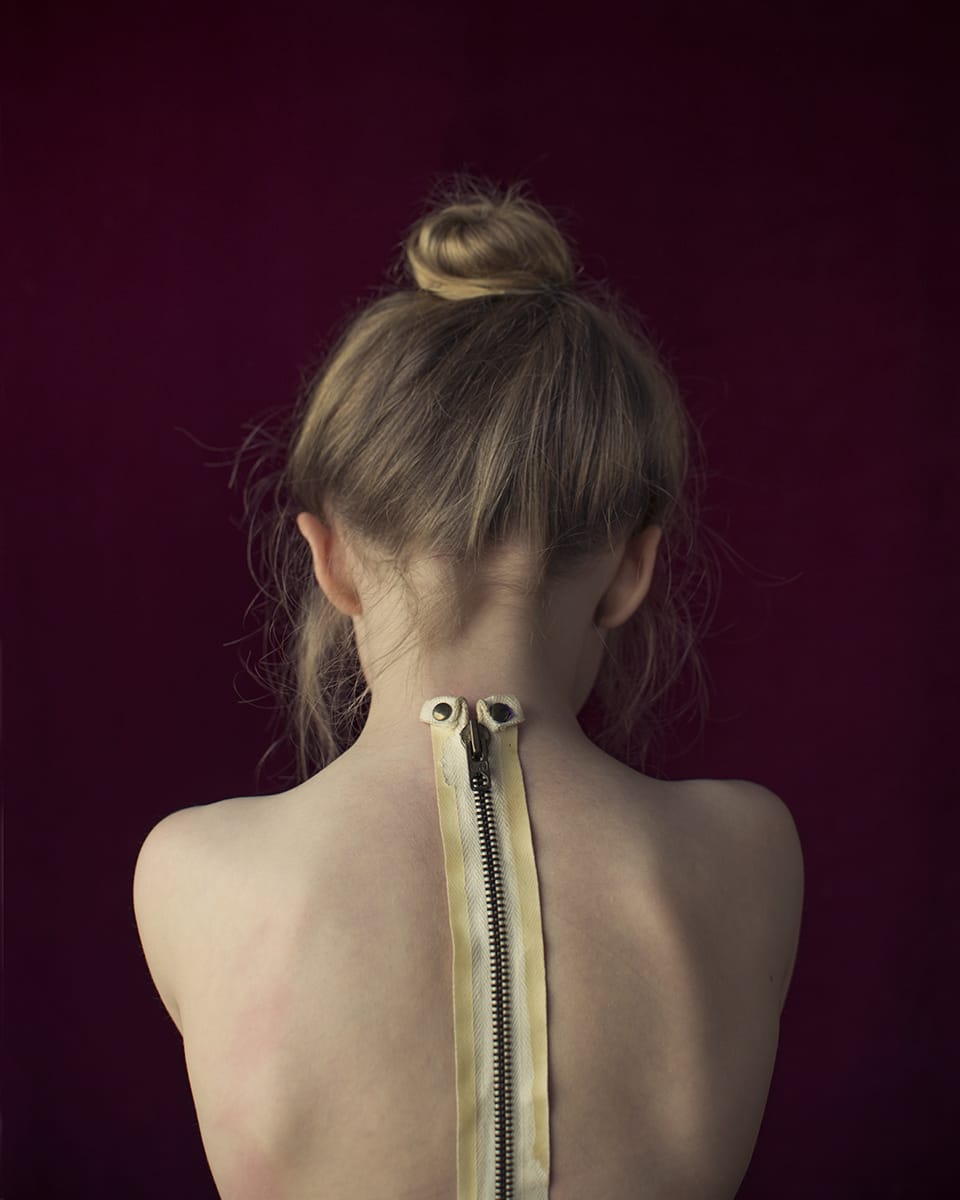
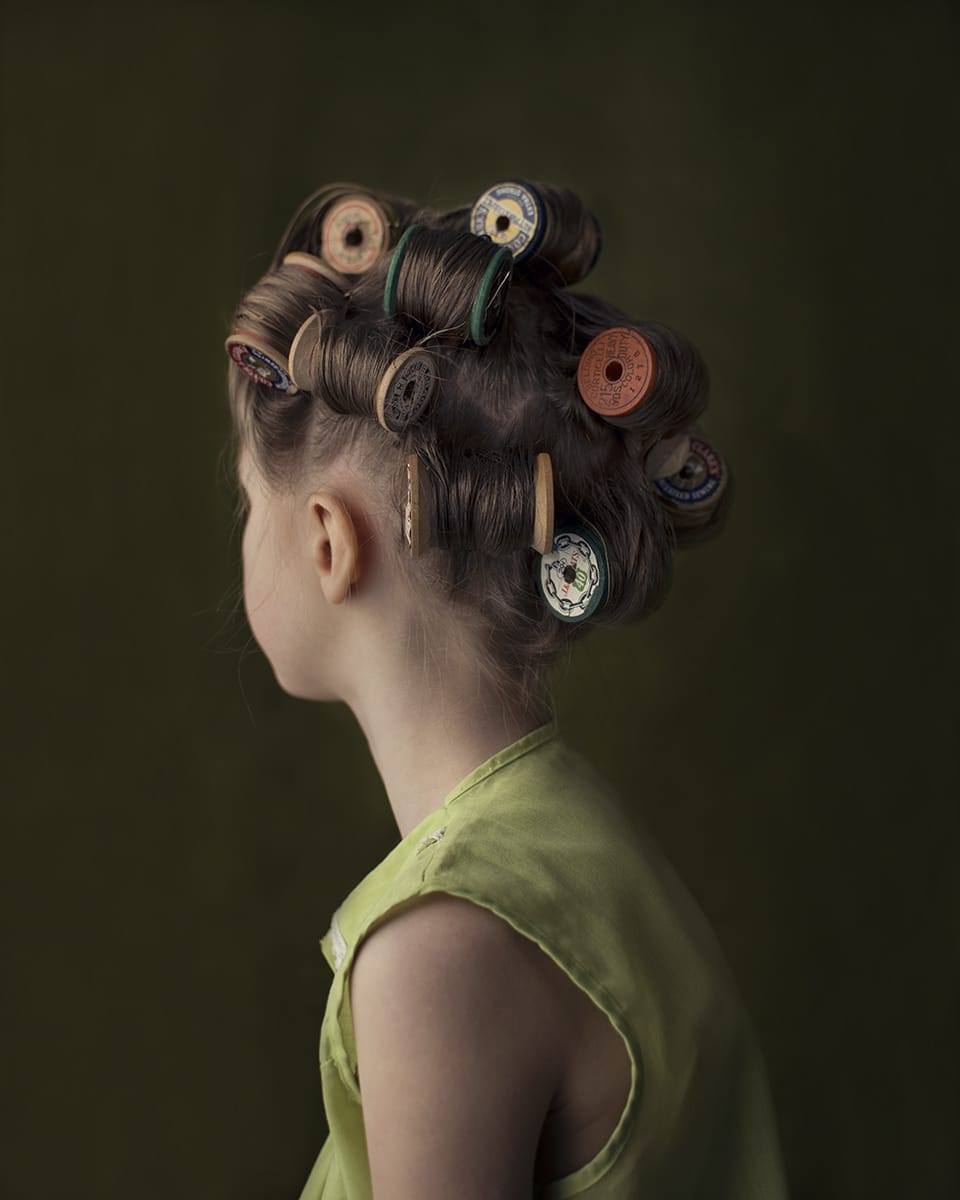
left, Zipper; right, Curl
What can you say about the new project?
It’s called Skipping Sundays. I remember growing up in the Methodist Church always feeling like an outsider in a way. I remember being at a church event, and the preacher asked, “How many of you guys have been saved?” I saw everyone putting their hands up, and I put my hand up too, so I didn’t feel like the odd one out. And I just remember as a middle schooler thinking, “What is this magical event, and why hasn’t this happened to me?” This was something that I struggled with for decades, always wondering how I could get to that place.
So, these images I’m making are about those Sundays, and creating different concepts about feeling on the outside of that religious experience.
I’m assuming faith is important in the town you grew up, living in the South?
Oh, yes.
Are you anticipating some pushback with this series, given the content?
I’ve already posted a few of these on Instagram, and people have emailed me telling me how much they relate. One person, who was a child of a preacher, even told me how much they saw themselves in the work. I mean, I’m sure I’ll get some pushback from people, but those aren’t going to be the people who are looking at this as an art form.
That’s a great point.
I know I won’t be able to please everyone, but how can you argue with somebody’s feelings, you know? And I make sure that I’m not putting anyone or the church down with the images, I’m just sharing what I’ve struggled with.
You’re asking questions, which is one thing I feel the church environment could use more of.
Right. Right.
Do you see any parallels between your investigation of memories and your decision to use photography as a medium, with photography being a mode of recording moments?
Of course. We have so many vintage family photographs that unveil past narratives and assist us in revisiting memories. It seems instinctive to utilize photography as a tool to delve into those memories.
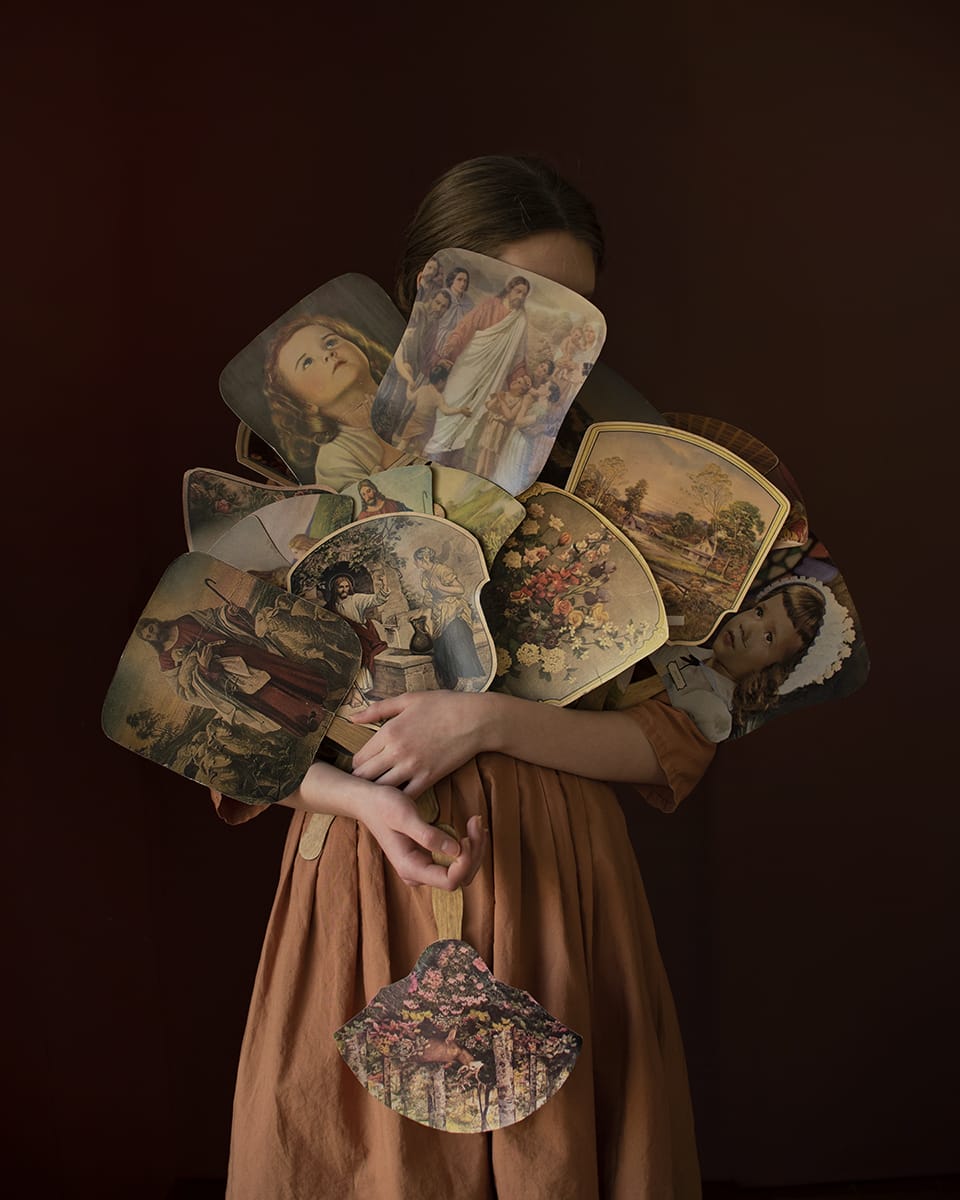
All That My Arms Can Hold
Definitely. How long after you decided to jump into this field and make work did you realize that you were good at photography?
I don’t know. When I got back into photography, I was heavy-handed at Photoshop. I cringe whenever I look back at those files, but I think I had to get that out of my system. You know, I was used to doing graphic design for so long and had to reframe how I used the tools for photographs. I would play around with different textures, and then after seeing a lot of other work, I learned how to strip down my edits where now the only edits I make are similar to a darkroom where I’m only lightening and darkening certain parts of the image.
But, I don’t know. I feel like maybe around the “Seen Not Heard” era is when I started to get good. I felt like I had the lighting and the layout dialed and that I made strong images. After that, I started to feel more confident in what I was doing.
I think it helps when you’re able to see your work in a gallery setting. It adds some validation.
Yeah. That’s also when my work started to turn more personal which, oddly enough, was easier to talk about and made me even more confident in my work.
I didn’t have much to say about some of the earlier stuff. Like, my work looked cool, but what did it really mean? So, I would try to make up something and it didn’t feel very authentic.
Oh, interesting! I can see that. I often find that successful work comes from your lived experience.
Yeah. But, I also go through these moments where I’ll see some other photographer’s work and I’ll just be like, “Oh, now I want to throw all mine out, too!” You know what I mean? You go through the ups and downs of doubt by comparison.
I feel like that’s just part of the art-making cycle.
Yep. My husband has gotten used to that. Every time he asks me how a shoot went, I’ll tell him I don’t think the work is good even though it usually is… But I’ve gotten okay with things not working out too. No one sees those images anyway. Haha.
Feel that, too. In terms of making your work, do you prefer the process or the result?
Hmm. I feel like my actual shoot time on set is probably 10 percent of the whole process. I spend the most time getting all the materials and preparing. But when it’s over, I almost feel a high in a way. And I can tell when I haven’t shot for a while because I’ll start to feel down, and then I’ll do another shoot and be in a great mood.
I mean, it’s interesting though because that tells me that photographing and the process of building to the shoots is important to me and I need to keep doing it. It’s a lot of eBay time.
It seems there are so many steps to your process, from ideas to sourcing products, and eventually shooting but it ends up being worth it. I think I know your answer from that alone. We covered a lot here, Heather. I appreciate your generosity. This has been fun.
It has been, thank you!
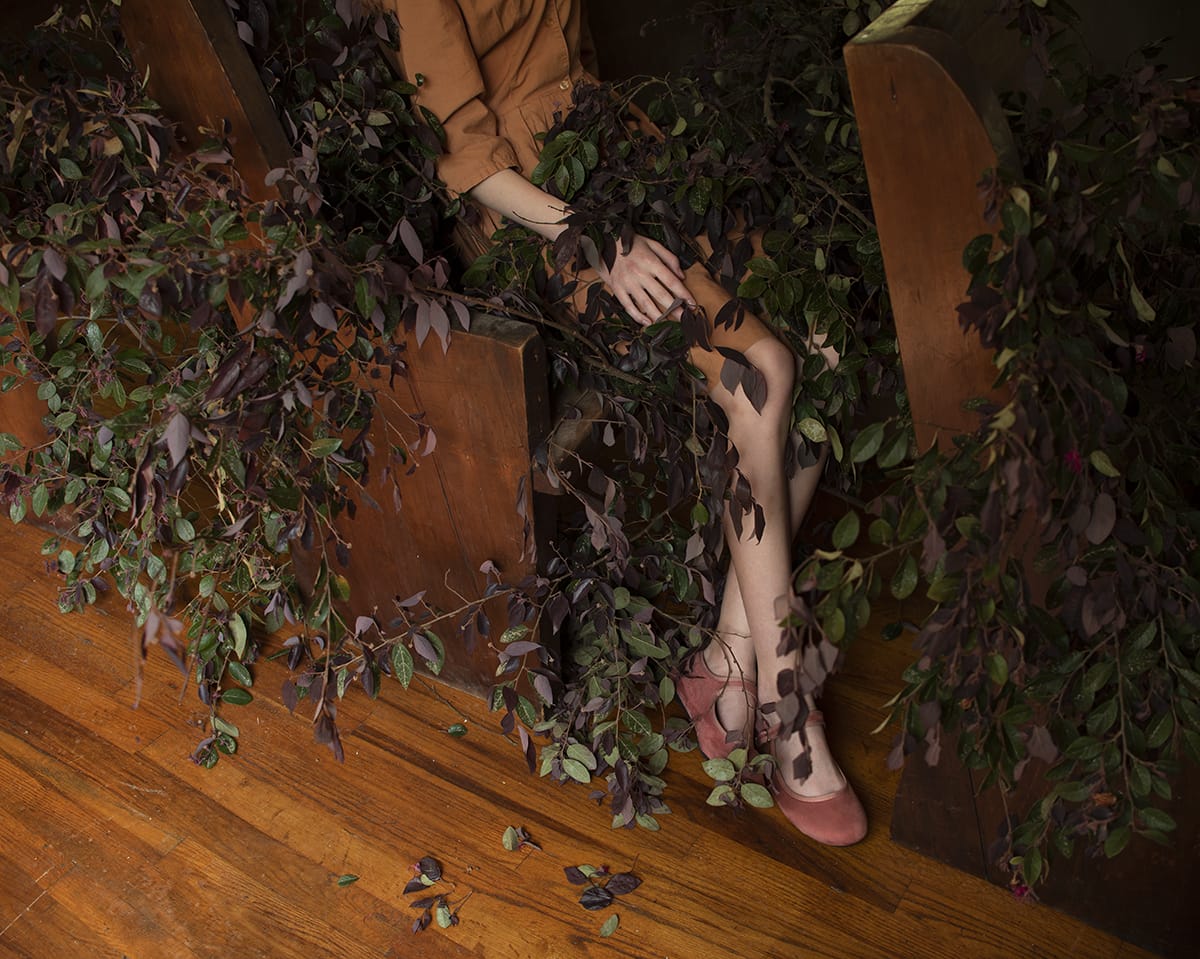
Since I Was Last There